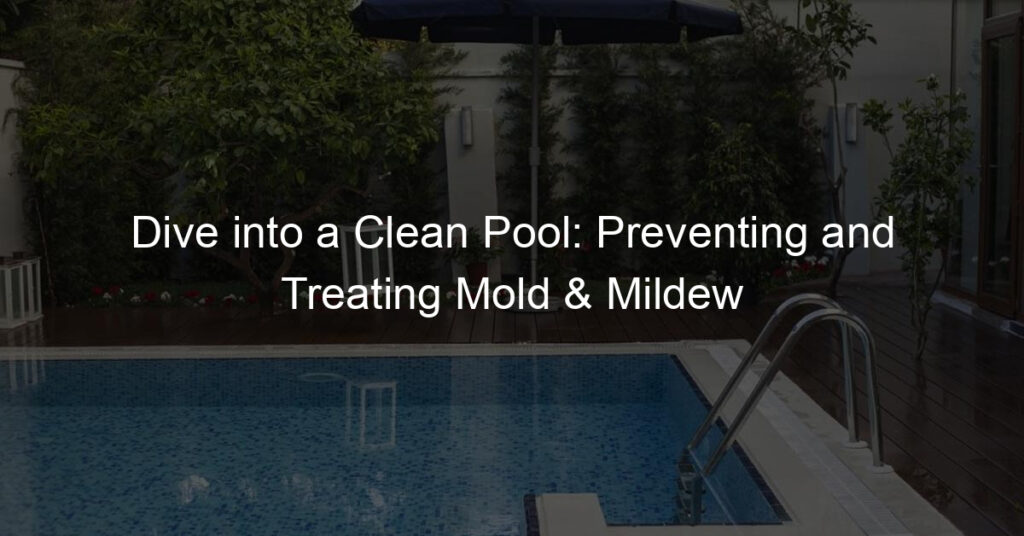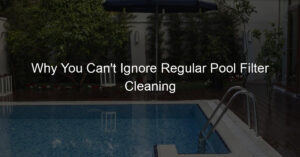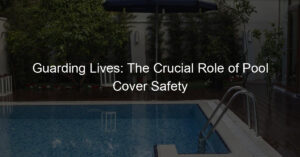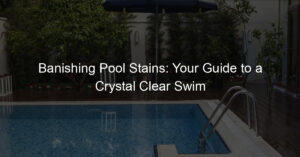Introduction to Pool Mold and Mildew
Having a swimming pool can be a lot of fun, especially during the hot summer months. However, it also comes with its own set of challenges. One of these challenges is dealing with pool mold and mildew. In this section, we will explore what pool mold and mildew are, why they are harmful, and how they can affect your swimming experience.
- Understanding the problem: Pool mold and mildew
- Why mold and mildew are harmful
Mold and mildew are types of fungi that thrive in damp and warm environments. They can grow almost anywhere there is moisture and organic material, including your swimming pool. Pool mold usually appears as a slimy, greenish-black substance on the pool walls, floor, or water surface. On the other hand, pool mildew is typically white or gray and has a powdery texture.
Both mold and mildew can multiply rapidly if not addressed promptly. They can make your pool look unappealing and can also cause various health issues. Therefore, it’s crucial to understand the problem and take appropriate measures to prevent and treat pool mold and mildew.
Mold and mildew are not just unsightly; they can also be harmful. They can cause a variety of health problems, especially for people with allergies or asthma. Exposure to mold and mildew can lead to symptoms such as coughing, wheezing, nasal congestion, and skin irritation. In severe cases, it can even cause lung infections.
Moreover, mold and mildew can damage the pool’s structure and equipment. They can cause discoloration and deterioration of pool surfaces, leading to costly repairs. Therefore, it’s essential to tackle the problem of pool mold and mildew as soon as it arises.
In the following sections, we will discuss how to prevent mold in pools, how to treat pool mildew, and how to remove mold from your swimming pool. We will also share some case studies and key takeaways to help you better manage and prevent pool mold and mildew. So, let’s dive in!
Preventing Mold in Pools
Preventing mold in your pool is crucial to maintaining a safe and healthy swimming environment. Mold can cause a variety of health issues and damage to your pool’s structure. Therefore, it’s essential to take preventive measures to keep your pool mold-free.
Pool Maintenance: Key to Prevention
Regular pool maintenance is the key to preventing mold growth. This involves regular cleaning and maintaining proper pool hygiene. Let’s delve into these aspects in more detail.
- Regular Pool Cleaning Tips
- Importance of Pool Hygiene
Regular cleaning is the first step in preventing mold in your pool. This includes skimming the pool surface daily to remove leaves and other debris. It’s also important to brush the pool walls and floor at least once a week to prevent algae and mold growth. Vacuuming the pool regularly can also help remove any debris that sinks to the bottom.
Pool hygiene plays a vital role in preventing mold growth. This means maintaining the right chemical balance in your pool water. Regularly testing your pool water and adjusting the chemicals as needed can help prevent mold and other harmful organisms from growing. Additionally, it’s important to keep the pool area clean and free of food and drink spills, which can attract mold and other pests.
In conclusion, regular pool maintenance and hygiene are crucial in preventing mold in pools. By following these tips, you can ensure a safe and healthy swimming environment for everyone.
Preventing Mold and Mildew: Best Practices
Preventing mold and mildew in your swimming pool is a crucial part of pool maintenance. By following these best practices, you can ensure a clean and healthy pool environment. Let’s dive into the details.
- Proper Water Circulation
- Regular Pool Inspections
- Using the Right Pool Cleaning Products
Ensuring proper water circulation in your pool is the first step in preventing mold and mildew. Stagnant water is a breeding ground for bacteria and fungi. A well-functioning pool pump and filter system will keep the water moving and reduce the chances of mold and mildew formation. It’s recommended to run your pool pump for at least 8-12 hours a day for optimal water circulation.
Regular pool inspections are essential in catching early signs of mold and mildew. Look out for any discoloration or slimy patches on the pool surface, as these could be signs of mold growth. It’s advisable to conduct a thorough pool inspection at least once a week. Remember, early detection can save you from costly repairs and health risks.
Using the right pool cleaning products is vital in preventing mold and mildew. Chlorine is a popular choice due to its ability to kill bacteria and fungi. However, it’s important to maintain the right balance of chemicals in your pool. Too much chlorine can cause skin and eye irritation, while too little can lead to mold and mildew growth. Always follow the manufacturer’s instructions when using pool cleaning products.
In conclusion, proper water circulation, regular pool inspections, and using the right pool cleaning products are the best practices to prevent mold and mildew in your pool. By following these steps, you can enjoy a clean and healthy pool all year round.
| Best Practices | Description |
|---|---|
| Proper Water Circulation | Ensure your pool pump and filter system are working properly to keep the water moving. |
| Regular Pool Inspections | Conduct a thorough pool inspection at least once a week to catch early signs of mold and mildew. |
| Using the Right Pool Cleaning Products | Use pool cleaning products as per the manufacturer’s instructions to maintain the right balance of chemicals in your pool. |
Treating Pool Mildew
Pool mildew is a common issue that can affect the cleanliness and safety of your swimming pool. It’s important to address this problem promptly to prevent further damage. Here’s a step-by-step guide on how to treat pool mildew effectively.
Mildew Treatment for Pools: Step-by-step Guide
- Identifying the Mildew
- Choosing the Right Treatment
- Applying the Treatment
- Preventing Future Mildew Growth
Mildew usually appears as a gray or white patch on the pool surfaces. It can also cause a musty smell. If you notice these signs, it’s likely that your pool has a mildew problem.
There are many products available for treating pool mildew. Some common options include chlorine-based cleaners and algaecides. It’s important to choose a treatment that is safe for your pool’s materials and effective against the type of mildew you have.
Follow the instructions on the product label to apply the treatment. This usually involves adding the product to the pool water and allowing it to circulate for a certain amount of time. Make sure to wear protective gear to avoid skin and eye irritation.
After treating the mildew, take steps to prevent future growth. This can include maintaining proper water chemistry, cleaning the pool regularly, and using a pool cover when the pool is not in use.
In conclusion, treating pool mildew involves identifying the problem, choosing the right treatment, applying the treatment, and taking steps to prevent future growth. By following these steps, you can keep your pool clean and safe for everyone to enjoy.
Swimming Pool Mold Removal
Swimming pool mold is a common problem that many pool owners face. Not only is it unsightly, but it can also pose health risks if not addressed promptly. In this section, we will guide you through the process of removing mold from your pool, ensuring it’s safe and clean for everyone to enjoy.
How to Remove Mold from Your Pool
Removing mold from your pool requires the right products and a systematic approach. Here’s a step-by-step guide to help you get rid of pool mold effectively.
- Choosing the right mold removal products
- Steps for effective mold removal
- Drain the pool: This will give you full access to the moldy areas.
- Scrub the moldy areas: Use a pool brush to scrub the mold off the pool surface. Be sure to wear protective gear to avoid direct contact with the mold.
- Apply the mold removal product: Follow the instructions on the product label. Ensure you cover all the moldy areas.
- Rinse and refill the pool: Once the product has done its job, rinse the pool thoroughly to remove any remaining product. Then, refill the pool with clean water.
- Test the water: Use a pool testing kit to ensure the water is safe for swimming. The pH level should be between 7.2 and 7.8, and the chlorine level should be between 1.0 and 3.0 ppm.
There are many mold removal products available on the market, but not all are suitable for swimming pools. Look for products specifically designed for pool use, which are safe for both the pool surface and swimmers. Chlorine-based products are commonly used due to their ability to kill mold and other bacteria.
Once you have the right products, follow these steps:
Remember, prevention is always better than cure. Regular pool maintenance and cleaning can help prevent mold growth in the first place. In the next section, we will discuss some effective strategies for preventing mold in pools.
Case Studies: Pool Mold and Mildew Solutions
Let’s delve into two real-life scenarios that highlight the importance of mold and mildew prevention and treatment in swimming pools. These case studies provide practical insights into the challenges faced and the solutions implemented to maintain a clean and healthy pool environment.
-
Case Study 1: Successful Mold Prevention in a Public Pool
The public swimming pool in the city of Springfield was facing a recurring issue of mold growth. The pool management decided to take proactive steps to prevent this issue.
Firstly, they ensured regular and thorough cleaning of the pool and its surroundings. They also installed high-quality pool filters and made sure they were cleaned and replaced regularly. Additionally, they maintained the pool’s pH level between 7.2 and 7.8, which is considered ideal for preventing mold growth.
As a result of these measures, the pool has remained mold-free for over a year now. This case study demonstrates that with proper maintenance and preventive measures, mold growth in public pools can be successfully avoided.
-
Case Study 2: Treating Severe Mildew in a Private Pool
Mr. Johnson, a private pool owner in the suburbs of Boston, was struggling with a severe mildew problem in his pool. Despite regular cleaning, the issue persisted.
He decided to seek professional help. The pool experts recommended a thorough deep-cleaning of the pool, followed by the application of a specialized anti-mildew treatment. They also advised Mr. Johnson to maintain the pool’s chlorine level between 1.0 and 3.0 ppm, as this can help prevent mildew growth.
Following these recommendations, Mr. Johnson was able to get rid of the mildew problem in his pool. This case study highlights the importance of professional intervention and the use of specialized treatments in dealing with severe mildew issues in private pools.
In conclusion, both these case studies emphasize the importance of regular pool maintenance and the use of appropriate preventive measures and treatments in dealing with mold and mildew issues in pools. It’s crucial to maintain the right chemical balance in the pool and ensure regular cleaning to keep these problems at bay.
Key Takeaways: Pool Mold and Mildew Prevention Tips
As we conclude our discussion on pool mold and mildew, it’s crucial to remember some key points. These points not only help in maintaining the aesthetic appeal of your pool but also ensure a healthy swimming environment.
- Importance of Regular Pool Maintenance
- Effective Strategies for Mold and Mildew Prevention
- Best Practices for Treating Pool Mold and Mildew
Regular pool maintenance is the first line of defense against mold and mildew. A clean pool is less likely to harbor these unwanted guests. Regular skimming, vacuuming, and checking the water chemistry can help prevent the growth of mold and mildew. Remember, prevention is always better than cure.
Preventing mold and mildew in your pool involves a combination of strategies. These include maintaining the right water chemistry, ensuring proper water circulation, and using algaecides when necessary. It’s also essential to keep the pool area clean and dry when not in use, as mold and mildew thrive in damp conditions.
If you spot mold or mildew in your pool, don’t panic. There are effective ways to treat these issues. First, identify the type of mold or mildew. Then, use the appropriate cleaning agents and techniques to remove it. Always remember to follow safety guidelines when handling pool chemicals. After treatment, monitor the pool closely to prevent recurrence.
In conclusion, maintaining a clean and healthy pool requires consistent effort and the right strategies. By following these key takeaways, you can prevent and treat mold and mildew effectively, ensuring a safe and enjoyable swimming experience for all.














